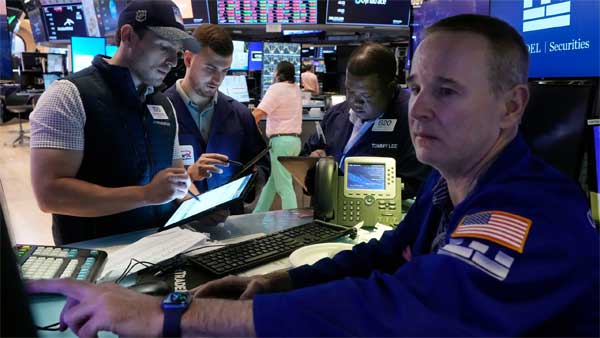Understanding Forex Market Slowdowns
The foreign exchange market, or forex, is renowned for its dynamism and the constant motion of currency trading. However, even this bustling environment experiences periods of slowdown, which can be perplexing to both novice and seasoned traders. Understanding these slowdowns is paramount for effective trading strategies. A slowdown can be characterized by reduced trading volume, decreased volatility, and narrower price spreads. These conditions can occur due to various factors which need to be explored in detail.
A significant reason for forex market slowdowns is the synchronization of reduced activity among major financial centers. When leading markets like New York, London, or Tokyo are simultaneously inactive or experiencing low engagement, the entire forex market can slow down. This synchronicity can be due to overlapping holidays or synchronized banking days off.
During slow days, traders often notice a lack of liquidity, leading to less favorable trading conditions. This can result in wider spreads and increased costs for traders attempting to execute positions. Understanding the nature of these patterns allows traders to prepare and adjust their strategies accordingly.
The impact of slow market days is not universally negative. For some traders, especially those employing long-term strategies, these days provide opportune moments to evaluate positions without the pressure of high volatility. It is crucial to recognize that slowdowns are inherent to the market’s cyclical nature and can sometimes offer strategic advantages.
Market participants must grasp the various causes of these slow periods to navigate effectively. By identifying the underlying reasons behind market slowdowns, traders can enhance their readiness and adaptability, ensuring their strategies remain robust despite reduced activity.
Global Holidays Affect Trading Volume
Global holidays play a pivotal role in forex market slowdowns. As the forex market operates 24/5 across different time zones, national holidays in major financial hubs like the United States, United Kingdom, and Japan can significantly dampen trading volume. When key players in these regions are inactive, the ripple effect is felt worldwide.
For instance, during Christmas or New Year’s Eve, trading volumes tend to plummet. These holidays are celebrated across many countries, leading to synchronized downtimes. The absence of traders from major banks and financial institutions during these periods contributes to the market’s sluggishness.
In addition to widely celebrated holidays, regional holidays can also impact the forex market. For example, the Chinese New Year leads to a slowdown in Asian markets, which affects currency pairs associated with the Chinese Yuan. Similarly, national holidays in European countries can lead to reduced activity in the Euro or British Pound.
The following table illustrates the impact of holidays on trading volume across different regions:
| Region | Major Holidays | Impact on Forex Volume |
|---|---|---|
| United States | Christmas, Thanksgiving | High |
| Europe | Easter, Summer Holidays | Medium |
| Asia | Chinese New Year, Golden Week | High |
Traders can benefit from being aware of these global holidays and adjusting their strategies accordingly. By planning trades around these slow periods, they can optimize for liquidity and market activity.
Understanding the cultural significance and timing of these holidays can provide traders with insights into expected market behavior. This knowledge can help manage expectations and avoid surprises during slow trading days.
Market Hours and Time Zone Impacts
The forex market operates across different time zones, which significantly influences trading activity. While the market is open 24 hours a day, the activity level varies based on the overlapping of major trading sessions. The market’s primary trading hours are divided into four sessions: Sydney, Tokyo, London, and New York.
The overlap between the London and New York sessions is known for its high trading volume and liquidity. Conversely, the gap between the New York and Sydney sessions is typically a time of reduced market activity, often referred to as the “forex dead zone.” During this period, traders experience less volatility and tighter spreads due to decreased trading volume.
Time zone differences also mean that certain currency pairs are more active at specific times. For instance, the USD/JPY pair sees increased activity during the Tokyo session, while the EUR/USD pair is more active during the London and New York sessions. Traders can use this information to time their trades for optimal activity and liquidity.
The variability in market hours means that traders need to be cognizant of when they are trading. Understanding the time zone impacts can help traders avoid periods of inactivity and capitalize on times when the market is more vibrant.

Moreover, the alignment of daylight saving time across different regions can cause temporary shifts in trading hours, affecting market dynamics. Traders must stay updated on these changes to prevent unexpected disruptions to their trading strategies.
By acknowledging the influence of market hours and time zones, traders can better strategize their trading activities, aiming to operate during peak hours to maximize their potential for profit.
Economic News and Data Release Lulls
Economic news and data releases are critical drivers of volatility and trading volume in the forex market. On days when there is a lull in significant economic announcements, the forex market can experience a noticeable slowdown. Traders often anticipate these releases to make informed decisions, leading to periods of inactivity when no major announcements are scheduled.
During the lead-up to major economic events, the market may experience a “wait-and-see” approach, with traders holding back until the data is released. This anticipation can lead to reduced trading activity and narrower price movements.
Conversely, the days following significant announcements can also be quieter, as traders digest the data and adjust their positions accordingly. Understanding this pattern allows traders to time their market entry and exits more effectively.
Some of the major economic indicators that impact forex trading include:
- Employment reports;
- Inflation data;
- Central bank interest rate decisions.
Traders need to be aware of the economic calendar and plan their strategies around these key data releases. When the calendar is light on announcements, traders may need to adjust their expectations for market movement and volatility.
A well-informed trader will use periods of economic lull to perform analysis or plan for upcoming trading opportunities. By understanding the impact of economic news and data release lulls, traders can maintain a steady approach and avoid making impulsive decisions based on low activity.
Influence of Major Market Participants
The forex market is heavily influenced by the actions of major market participants, including central banks, financial institutions, and large corporations. These entities have the power to significantly impact market trends and liquidity. When these players reduce their trading activity, the market can experience a slowdown.
Central banks play a critical role in the forex market as they manage national currency values and influence interest rates. When central banks are inactive or have no scheduled announcements, market activity can diminish. Conversely, when central banks are actively intervening in the currency markets, trading volumes can spike.
Large financial institutions and corporations engage in forex trading for hedging and speculative purposes. Their participation is often linked to global economic cycles and financial market conditions. When these entities pull back from trading, possibly due to uncertainty or unclear market signals, the market experiences reduced activity.
Retail traders, although smaller in size, collectively contribute to market dynamics. However, their influence is often overshadowed by the larger players. Understanding the behavior of these major participants can provide traders with insights into potential market slowdowns.
Traders can benefit from tracking the actions of these major participants and considering them in their trading strategies. This understanding helps predict market behavior, especially during periods of reduced activity from these influential players.
By analyzing the influence of major market participants, traders can better navigate the forex market, making more informed decisions and optimizing their trading outcomes.
Impact of Geopolitical Uncertainties
Geopolitical uncertainties are another key factor that can lead to slow days in the forex market. Events such as political unrest, elections, and diplomatic tensions can create an atmosphere of uncertainty, causing traders to adopt a cautious stance.
During times of geopolitical instability, traders often resort to safe-haven currencies like the US Dollar or the Swiss Franc, leading to a reduction in trading activity for other currency pairs. The uncertainty surrounding potential geopolitical developments can lead to indecision and reduced market participation.
Moreover, geopolitical events can lead to temporary disruptions in market functioning. For instance, unexpected election outcomes or sudden geopolitical crises can trigger rapid shifts in market sentiment, subsequently leading to a slowdown as the market reassesses the situation.
Traders must keep abreast of geopolitical developments and understand how these events can impact currency values. By staying informed, traders can anticipate potential slowdowns and position themselves strategically to either capitalize on volatility or avoid unfavorable conditions.
A proactive approach to managing geopolitical risks involves incorporating geopolitical analysis into trading strategies. This includes setting stop-loss orders and using options to hedge against unforeseen market movements triggered by geopolitical events.
Ultimately, understanding the impact of geopolitical uncertainties on the forex market allows traders to better manage risk and navigate periods of reduced market activity, ensuring they remain competitive and successful.
FAQ on Forex Market Slowdowns
1. What causes slow days in the forex market?
Slow days can result from global holidays, time zone differences, lack of economic news, reduced activity by major players, and geopolitical uncertainties.
2. How do global holidays affect forex trading?
Global holidays, especially in major financial centers, lead to reduced trading volumes and liquidity, causing slowdowns in the forex market.
3. How do time zones impact forex market activity?
The forex market operates across different time zones, with activity levels peaking during overlapping trading sessions like London and New York, while other times see reduced activity.
4. Why does a lull in economic news cause market slowdowns?
Without significant economic announcements, traders may adopt a wait-and-see approach, leading to reduced trading activity and narrower price movements.
5. How do major market participants influence market slowdowns?
When central banks or large financial institutions reduce trading activity, it can lead to diminished market liquidity and a slowdown.
6. What role do geopolitical uncertainties play in forex slowdowns?
Geopolitical events create uncertainty, leading traders to seek safe-haven currencies and reduce participation in other currency pairs, causing market slowdowns.


Interesting read on forex slowdowns. The synchronization of low activity across major financial centers makes sense, as they are the drivers of the market.
I never took into account how much global holidays could affect my trading volume. This article was quite informative on the matter.
Good to know about the ‘forex dead zone’. I’ll plan my trades around the more active market hours to avoid slow periods.
This article highlights why it’s important to stay updated on economic news. Economic lulls can impact trading strategies significantly.
Understanding how major market participants move is key to navigating forex slowdowns, as mentioned here. Their influence can’t be underestimated.
‘Slow days’ in forex aren’t necessarily bad, as this post points out. They give you time to re-evaluate your strategy without the pressure of volatility.
‘Geopolitical uncertainties affecting market slowdowns is a critical point. Keeping informed on world events seems more important than I realized.
‘Market Hours and Time Zone Impacts’ section is a great reminder for traders like me who need to consider when we’re placing trades globally.